.png)
When Critchlow Geospatial applied for co-funding from New Zealand government in 2020 to build a tool that would assist fleet operators to compare and contrast an electric vehicle fleet to their current ICE fleet, we knew that we were entering uncharted territory.
What was missing from the tools available at the time was the ability for people to assess their EV requirements by answering the question “what do we need, based on where we go and what our payload is?”.
Critchlow responded to this complex informational challenge by creating SwitchMyFleet, a free-to-air website that enables fleet operators to compare the costs and the results of various fleet sizes and vehicle configurations, including battery sizes.
It combines the physics of moving vehicles, New Zealand geospatial data, and route optimisation algorithms to provide an easy-to-use tool that balances time, distance, and energy use to calculate the metrics that fleet operators and transport businesses need to build their business cases for transition.
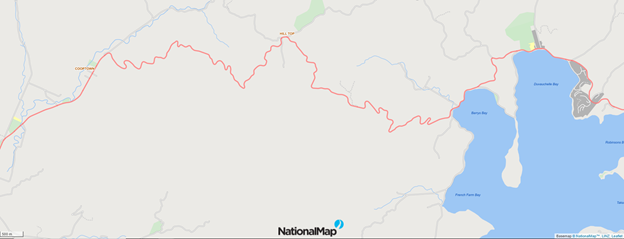
One of the most talked about barriers in switching from ICE vehicles to EV vans and trucks is range anxiety. People are looking for evidence that an EV can do the job as well as or better than an ICE vehicle. They are legitimately concerned about the loss of time and productivity while a vehicle recharges, or the risk that vehicles will limp back to base with little battery charge left.
SwitchMyFleet has been engineered so that EVs return to base with comfortable levels of spare battery – no matter where they go. Problem solved … but wait. Is it?
Stating the obvious, New Zealand is a hilly country. If most commercial EVs are used within cities, or travelling from cities to satellite towns and back, fleet operators will be wondering what the impact terrain has on battery usage, which might make them question the suitability of EVs for the job. There are 3 factors that must be considered:
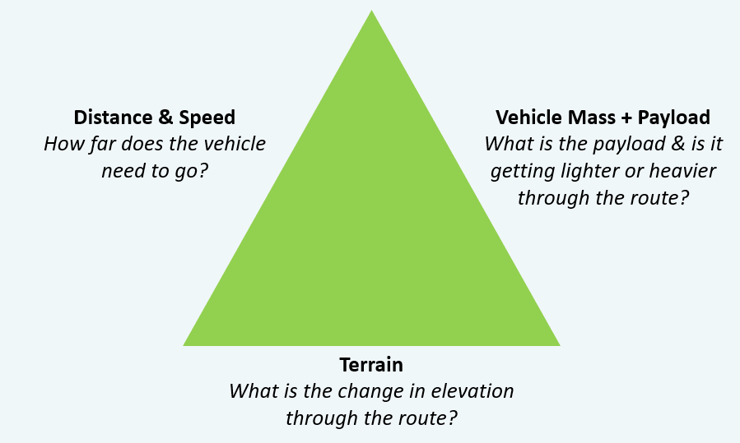 Figure 1 - Balancing the 3 journey components
Figure 1 - Balancing the 3 journey components
We’ve done some research into this, applying the physics of moving vehicles, geospatial data, and route optimisation algorithms, and the results might very well surprise you – and give you the confidence to transition to EVs sooner rather than later.
We analysed two types of vehicles to test our hypothesis: 1. a light truck (4 ton vehicle mass; 3 ton payload) and 2. a medium truck (8 ton vehicle mass and 6 ton payload). This story is about the results of the light truck (a suitable choice for our scenario).
There will be a future story about the medium truck (hint: the results are similar).
We tested a scenario where a Christchurch-based business delivers goods to Akaroa (our winding, hilly road) and Ashburton (our flat, fast road) – about 160kms for both return journeys.

 Figures 2 & 3 - Long sections of the two routes
Figures 2 & 3 - Long sections of the two routes
For deliveries to satellite towns from major centres, we thought that fleet owners or owner-drivers might consider a 4-ton light truck with a 3-ton payload and for the battery size, we chose 150 kWh.
Our vehicles will follow optimised routes that consider time, distance, average road speeds, and road types.
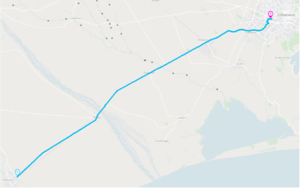 Our hypothesis here was that the EV would not require a recharge en route because the route is relatively flat, and the road speed is relatively constant. We assumed that the energy used would be considerably less than the Christchurch to Akaroa journey because the route along SH1 is a flatter (albeit faster) road.
Our hypothesis here was that the EV would not require a recharge en route because the route is relatively flat, and the road speed is relatively constant. We assumed that the energy used would be considerably less than the Christchurch to Akaroa journey because the route along SH1 is a flatter (albeit faster) road.
Figure 4 – Christchurch – Ashburton route (81 km one way)
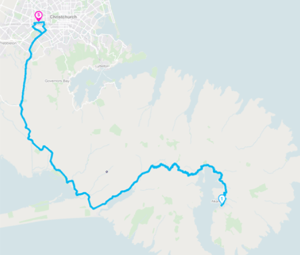 We hypothesised that the number of hills and the steep gradient of those hills on State Highway 75 between Christchurch and Akaroa would mean that the driver would need to recharge the EV in Akaroa in order to make it back to base in Christchurch. Due to the number of steep hills and the small distances between them, the EV would not have sufficient “bandwidth” to regenerate much energy through braking.
We hypothesised that the number of hills and the steep gradient of those hills on State Highway 75 between Christchurch and Akaroa would mean that the driver would need to recharge the EV in Akaroa in order to make it back to base in Christchurch. Due to the number of steep hills and the small distances between them, the EV would not have sufficient “bandwidth” to regenerate much energy through braking.
Figure 5 – Christchurch – Akaroa route (81 km one way)
The EV model forecasts that the energy demand is the same for both journeys. This is despite the EV having to climb to 470m – twice – on the Akaroa journey.
| Vehicle Type: Light Truck | Christchurch to Ashburton | Christchurch to Akaroa |
| Laden | 57 kWh | 56 kWh |
| Unladen | 44 kWh | 45 kWh |
| Energy Economy | 62 kWh/100km | 63 kWh/100km |
The graphs below illustrate the cumulative energy consumption for each return journey of the same distance - one with a significant hill. You can see that in the Christchurch to Akaroa return journey, the EV recovers enough energy going downhill to effectively “flatten” any impact of the hill.
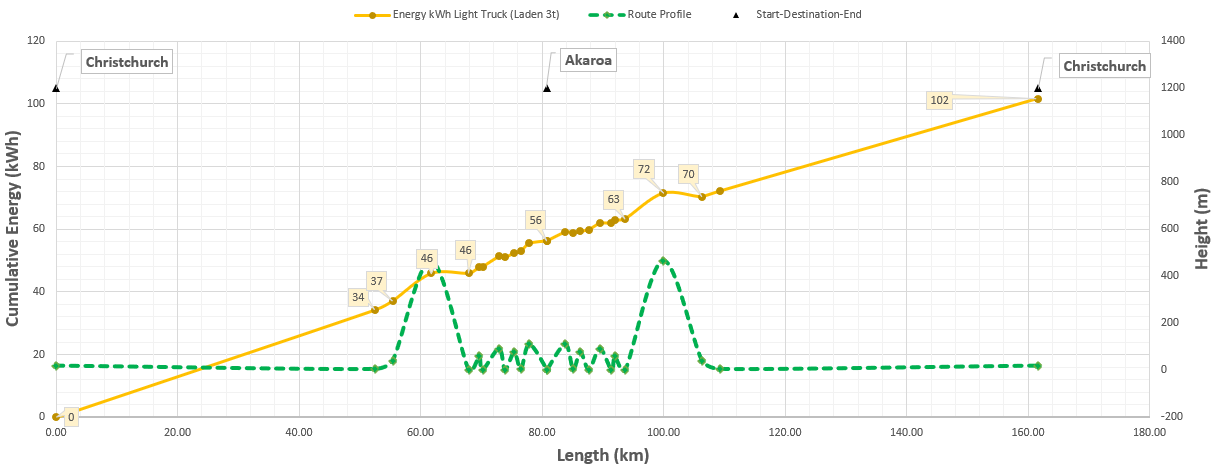 Figure 6 – Christchurch – Akaroa journey energy consumption through the route
Figure 6 – Christchurch – Akaroa journey energy consumption through the route
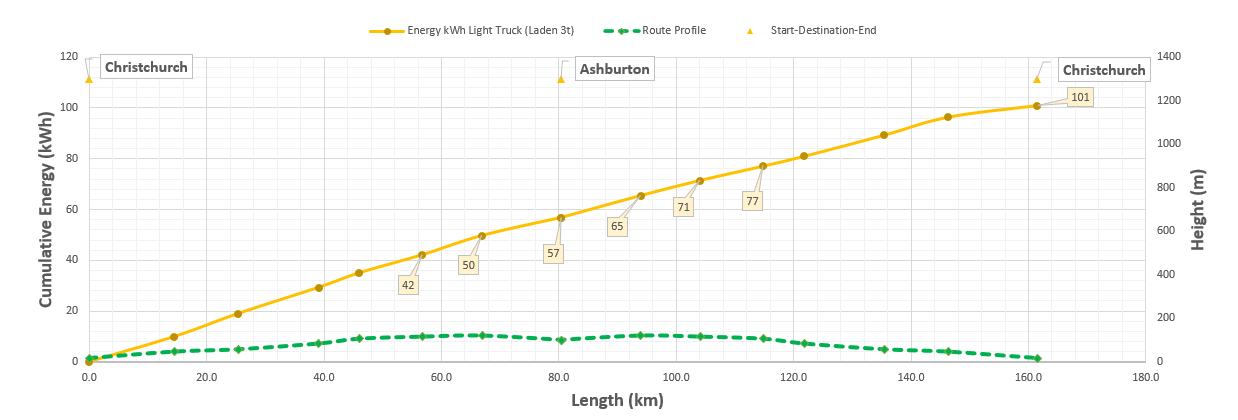 Figure 7 – Christchurch – Ashburton journey energy consumption through the route
Figure 7 – Christchurch – Ashburton journey energy consumption through the route
It appears that hills enroute won't add to an EV's energy consumption, as long as you specify the correct battery size for your expected journeys.
New Zealand’s fleet operators are just beginning their transition to EVs. With a growing selection of EV van and truck models becoming available here, SwitchMyFleet will arm them with metrics that reflect their business’ “real world”, enabling the transition with greater confidence and perhaps at a faster pace.
This is a model that we hope allays some anxiety about the suitability of commercial EVs in hilly routes. However, it is a model and what we need now is real world calibration data to validate these findings. Although this blog is specific to a light truck, we have also modelled medium truck (more on that in a future post).
So, if you would like to provide calibration data for EV energy consumption in hilly terrain for either a light or medium truck, please get in touch.
Let’s help New Zealand fleet operators transition to EV’s that are right for the job.
We promise we won't spam your inbox with unnecessary emails. Privacy Policy